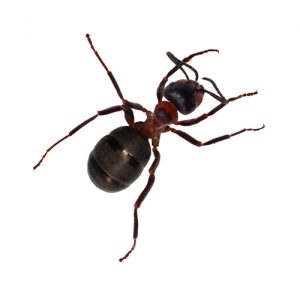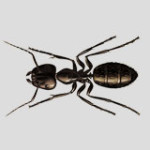I Have Small Ants In My House, What Kind Are They?
By Chris Williams on January 17, 2011.
Q. I have these small ants in my home. Which one is it?
A. Okay the first thing is to define what you consider to be small. Many times we respond to complaint calls for ants and the homeowner has carpenter ants. In relation to other household ant species, carpenter ants are gigantic! In general for this discussion, ants less than ¼ inch in length we’ll call small.
After almost thirty years as a working entomologist in northern New England, just four species account for nearly all of the thousands of small nuisance ant calls I’ve personally observed. Overall, I would rank them in terms of their importance like this (1.) Odorous house ant, (2.) Pavement ant, (3.) Pharaoh ant, and (4.) Acrobat ant. Now, this is just my bias in terms of numbers of complaints I’ve observed over a period of time. Obviously, whichever species you are currently dealing with, as a homeowner/renter or apartment dweller is the most important to you!
 Now, while nothing beats having an expert observe the ant under a lens, (or yourself and see if you can compare it with a high quality image) situational living may easily help you identify which one you are dealing with. I’ll cover some basic descriptions and behaviors of the four species just a bit later. By situational living, (and remember I’m only speaking about New England) I mean where YOU are living, and what you’ve observed the ants doing.
Now, while nothing beats having an expert observe the ant under a lens, (or yourself and see if you can compare it with a high quality image) situational living may easily help you identify which one you are dealing with. I’ll cover some basic descriptions and behaviors of the four species just a bit later. By situational living, (and remember I’m only speaking about New England) I mean where YOU are living, and what you’ve observed the ants doing.
If you live on the ground floor of a twenty four-unit apartment building, or in a single family home built on a slab and you start to notice little sand piles around a toilet or along the edge of a baseboard radiator or boiler, (especially during the colder months) then you probably have pavement ants. Every winter we receive calls for these small, (1/8 inch) slow moving reddish brown ants. While it is too cold during the winter for pavement ants to forage outdoors for food, the temperature below a foundation slab is stabile enough to keep them active all year long. Pavement ants will forage inside your home by gaining access around pipes (toilet or radiant heat) or minor cracks in the slab. Now if you live in that same twenty four-unit apartment on the third floor and you see very tiny (1/16inch) reddish yellow ants trailing down walls or coming out of an electrical outlet or living in really unusual spots like appliances, (especially coffee makers), or even a desk drawer, you have pharaoh ants. Pharaoh ants are commonly found around water sources such as sinks, shower stalls, and toilets in apartment buildings, hotels and condominiums and other commercial buildings. They are believed to have originated from Africa and are now found throughout the US. In colder regions of the country like New England, these ants live entirely indoors and they are often serious pests in hospitals.
 The last two pest species of ants to look at are from my experience, mostly exclusive to single-family homes. If it is still relatively cool outside (late winter/early spring) and you have small, (1/8 inch) active, dark brown ants crawling on counters, invading cabinets or the dishwasher, then these are probably odorous house ants. Odorous ants? Yes, their common name was given to them for the peculiar odor (some say rotten coconut) they give off when crushed. Last winter (2010) was relatively mild with almost no snow cover by the first week of March and I found these ants entering a client’s home to forage from outdoors. They were nesting under a pile of fieldstones that had warmed up nicely with the strong March sun. Although I’ve occasionally found odorous house ants nesting within the home, most of the service calls I’ve been on have involved ants living outdoors and foraging inside. This is especially true in warmer weather when these ants actively trail. Finally, it is summer time and you’ve noticed a very long trail of odd looking small (1/8 inch) brown ants leading from the outside into your home or heading up under the siding toward the attic. Or, maybe you’ve spotted ants dumping fairly fine sawdust out of your shiplap ceiling. Although it sounds like carpenter ants, you probably have acrobat ants. They are called acrobat ants because of the weird way they raise up their abdomen (the third body segment) when disturbed or threatened. Acrobat ants are also pretty easy to identify because that third body segment is heart-shaped. I think (I hope so anyway!) you now should have a pretty good idea about what species of small ant is bugging you based upon your unique living situation here in northern New England.
The last two pest species of ants to look at are from my experience, mostly exclusive to single-family homes. If it is still relatively cool outside (late winter/early spring) and you have small, (1/8 inch) active, dark brown ants crawling on counters, invading cabinets or the dishwasher, then these are probably odorous house ants. Odorous ants? Yes, their common name was given to them for the peculiar odor (some say rotten coconut) they give off when crushed. Last winter (2010) was relatively mild with almost no snow cover by the first week of March and I found these ants entering a client’s home to forage from outdoors. They were nesting under a pile of fieldstones that had warmed up nicely with the strong March sun. Although I’ve occasionally found odorous house ants nesting within the home, most of the service calls I’ve been on have involved ants living outdoors and foraging inside. This is especially true in warmer weather when these ants actively trail. Finally, it is summer time and you’ve noticed a very long trail of odd looking small (1/8 inch) brown ants leading from the outside into your home or heading up under the siding toward the attic. Or, maybe you’ve spotted ants dumping fairly fine sawdust out of your shiplap ceiling. Although it sounds like carpenter ants, you probably have acrobat ants. They are called acrobat ants because of the weird way they raise up their abdomen (the third body segment) when disturbed or threatened. Acrobat ants are also pretty easy to identify because that third body segment is heart-shaped. I think (I hope so anyway!) you now should have a pretty good idea about what species of small ant is bugging you based upon your unique living situation here in northern New England.
Here are some quick descriptions of the four species:
- Pavement ant: 1/8-inch long, reddish brown, head has grooves and is equal to or slightly larger than abdomen, two nodes*. Slow moving, and will often dump out little sand piles where nesting.
- Odorous House ant: 1/8-inch long, dark brown to black, single node*. Active. Gives off peculiar odor when crushed.
- Pharaoh ant: 1/16-inch long, reddish yellow, two nodes*. Moderately active and will nest in unusual places indoors only.
- Acrobat ant: 1/8-long, dark brown, sometimes bi-colored, two nodes* Moderately active and will nest in moisture damaged wood in homes often dumping out fine sawdust.
*Nodes are little bumps or plates that make up the attachment point (or petiole) between the abdomen (third segment) and the thorax (middle segment) of the ant’s body and are an important tool used to differentiate the species.
Sign up for our biweekly email newsletter for more information about bugs and pests!